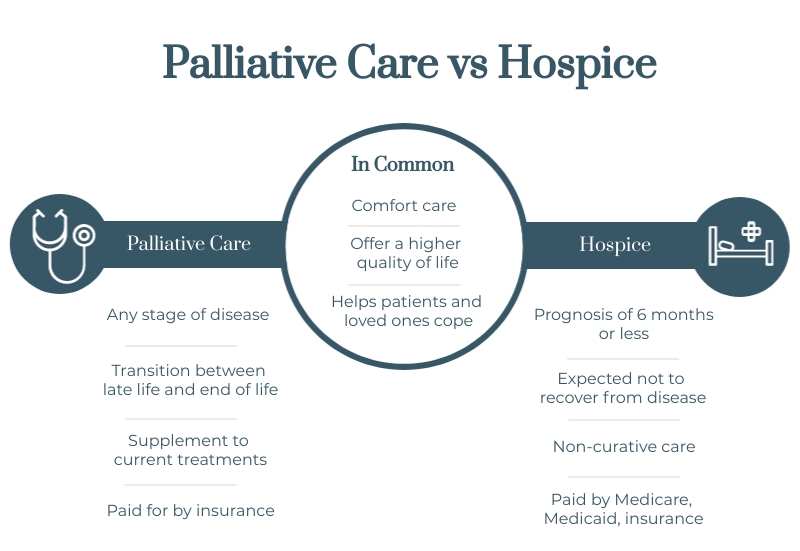Palliative Care vs Hospice: What is the Difference?

If you are considering palliative care or hospice for a loved one, you have been in a difficult situation for days, weeks, or even months. And the chances are good that you are feeling emotional, stressed out, and potentially even overwhelmed. That’s ok!
Take a second right now to just breathe.
The end-of-life stage is a challenge for every family, and all of these feelings are perfectly normal. This is especially true if you’re new to the process of seeking compassionate care.
This article will walk you through the differences between palliative care and hospice in simple and easy-to-understand terms. This information will help you decide which service best suits your current situation.
Now take one more deep breath, and keep reading for all the details.

What Is Palliative Care?
Palliative care is for patients at any stage of illness. Palliative care programs are designed to ease physical pain and assist with other health issues when an illness is serious and potentially life-limiting.
This type of treatment is most commonly used to help patients living with the pain and symptoms of chronic diseases. It also helps family members and caregivers cope with the challenges of medication schedules, reduced or limited mobility, and coping with the side effects of treatments.
Palliative care is not intended to replace other treatments. Instead, think of it as a supplement to assist with serious symptoms and improve a patient’s quality of life overall.
Patients generally “pass through” palliative care, meaning that it is a transitional step in between late life and the end of life. And, while it does often lead to hospice care, it doesn’t necessarily have to.
What Is Hospice Care?
By contrast, hospice care is intended for patients who are not expected to recover from their terminal illness. It can include many of the same elements as palliative care but also comes with some distinct differences.
The first and most notable is the treatment of illness. In most cases, curative medical treatments end when hospice begins. So, the goals of care shift from cure to comfort. The goal of hospice is to improve the quality of life and allow the hospice patient to make the most of the time that remains.
Like palliative care, hospice focuses on managing medications and symptoms, especially pain. Hospice care also puts emphasis on easing psychological symptoms and helping both patients and their families prepare for the end of life.
In most cases, hospice patients have a life expectancy of six months or less. And, depending on the severity of their symptoms, treatment can take place in an inpatient setting, like a hospital or nursing home – or home care.
Because this type of treatment addresses such a wide variety of physical and psychological issues, hospice care requires more than just medical care. In addition to physicians, nurses, and aides, chaplains, social workers, music therapists, volunteers, and bereavement specialists are typically a part of the team. These trained professionals can help with the grieving process and offer assistance in processing difficult emotions such as anger, sadness, and regret.
One of the myths of hospice is that it is only for patients who are actively dying. Every hospice experience is unique and individualized, and the length of time that a patient is on hospice varies by person based on their disease progression.

Palliative Care vs Hospice
While these two treatment types are radically different, hospice and palliative care have plenty in common.
These two types of care help patients and their families make difficult decisions associated with the end of life. This can include creating an end-of-life plan, similar to a birth plan, that outlines final wishes. This can include everything from medical desires such as resuscitation preferences, to who makes legal decisions if the patient is unable to, and even making funeral arrangements.
Both palliative and hospice care are intended to offer a higher quality of life rather than extending a patient’s life. This gives loved ones a chance to spend time together and enjoy each other’s company, focusing on closure and making some final happy memories together.
Palliative Care or Hospice: Which Is Right for Your Circumstances?
If you are not sure where your loved one stands in the end-of-life process, it’s ok to ask for professional guidance. There are many non-medical programs associated with end-of-life care that can help you make the decision. These often include sessions with nurses and social workers – to help you accurately assess the situation and make decisions.
This is also an opportunity to get connected with community resources such as food pantries, emotional support groups, transportation services, and free legal services. And, if you are able, this is a good time to create an end-of-life plan, if you have not already.
Keep in mind that palliative and hospice care move at their own pace, and no two experiences are the same. Patients can spend days, weeks, or months in either or both stages of the process. That is ok!
No matter where you and your loved one are in this challenging process, the biggest goals are comfort and quality of life. And, by reading this article, you’ve already taken the first step.
You Can Do This!
Now that you know a bit more about the differences between palliative care vs hospice, you should have a better idea of which compassionate end-of-life care is best for your loved one. And, if you still don’t feel 100% sure about a decision, don’t worry.
You and your family are going through a difficult transition. Each day is different, and in many cases, there are no right answers. So, don’t be hard on yourself!

